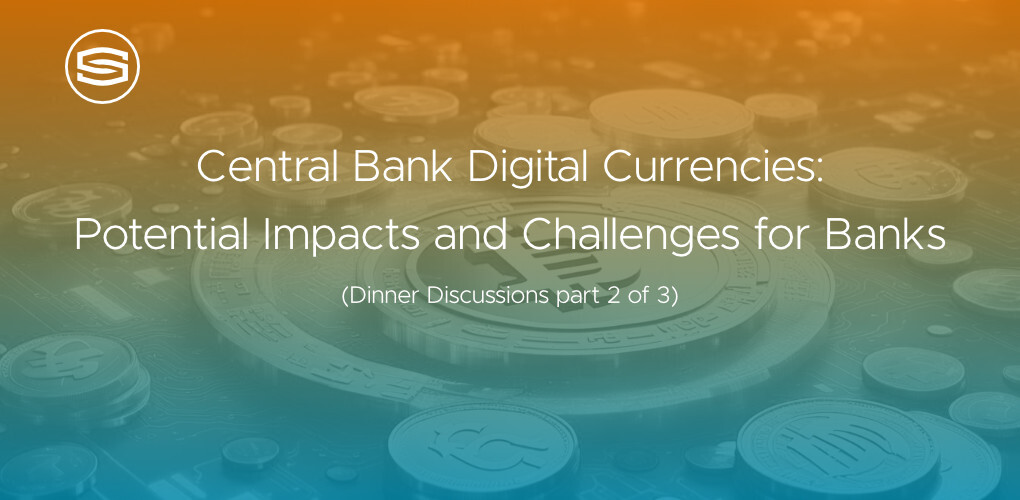
Insights & Opinions
Central Bank Digital Currencies: Potential Impacts and Challenges for Banks
Mon, 29 Jul 2024


Following on from last week’s post summarising the discussions about ethics and regulation for AI in banking, here we share the discussions that took place over the second course of the intimate round-table dinner we held with banking professionals.
Central Bank Digital Currencies (CBDCs) remain a divisive topic in the financial sector, generating a mix of excitement and concern. As governments and central banks explore the possibilities of issuing digital currencies, the banking industry must prepare for the profound changes that CBDCs could bring.
We considered the potential impacts and challenges of CBDCs on banks and the broader financial ecosystem.
Understanding the Purpose of CBDCs
One of the most pressing questions surrounding CBDCs is their purpose. What problems are CBDCs intended to solve? Proponents argue that digital currencies could streamline payment systems, enhance financial inclusion, and provide a more secure and efficient means of conducting transactions.
However, sceptics question whether CBDCs are a solution in search of a problem. A speaker at Money20/20 had suggested earlier that day that perhaps CBDCs need product managers who can clearly identify the value proposition for the target audience and even “who” the intended audience actually is!
The debate highlighted the need for a clear articulation of the specific use cases and benefits of CBDCs.
The Impact on Banks' Lending Capabilities
A significant concern among bankers is the potential impact of CBDCs on their ability to lend. Traditional banks rely on customer deposits to fund loans and mortgages. Banks could face a liquidity shortfall if a substantial portion of the public's deposits is held in CBDCs rather than in traditional bank accounts. This could disrupt their lending operations and impair their ability to provide essential financial services.
The challenge lies in balancing CBDCs' payment and “value store” functionality with banks' credit function. Experts suggest that separating these functions could mitigate some of the risks. However, this approach raises further questions about the mechanics of such a split and its feasibility in practice.
Privacy and Security Concerns
Privacy is a paramount concern in the implementation of CBDCs. While digital currencies offer the potential to enhance anti-money laundering (AML) and know-your-customer (KYC) processes, they also pose significant privacy risks. The centralisation of financial data could lead to increased surveillance and a loss of personal privacy. The cost and complexity of addressing these privacy concerns are substantial, and some argue that the trade-offs may not be worth the benefits.
The example of China's digital yuan underscores these concerns. Observers are closely watching China's approach to CBDCs, noting both the technological advancements and the potential for state control and surveillance. The balance between enhanced security and privacy protection remains a critical issue that needs careful consideration.
Financial Inclusion and Digital Divide
CBDCs must promote digital inclusion for them to be effective. However, there was a feeling that there is currently insufficient focus on addressing the needs of the digitally excluded, including older adults, individuals with disabilities, and those from economically disadvantaged backgrounds. A digital currency that excludes significant portions of the population risks exacerbating existing inequalities.
Ensuring that CBDCs are accessible and usable for all requires comprehensive strategies to bridge the digital divide. This includes providing the necessary infrastructure, education, and support for widespread adoption. CBDCs' benefits could be unevenly distributed without these measures, undermining their potential to enhance financial inclusion.
The Role of CBDCs in the Digital Financial Ecosystem
Integrating CBDCs into the existing digital financial ecosystem presents several challenges. One critical question is how CBDCs will interact with current payment systems and financial instruments. For instance, will CBDCs complement or compete with cryptocurrencies? While cryptocurrencies like Bitcoin are often viewed as speculative assets rather than true currencies, CBDCs aim to function as stable and reliable forms of money.
Moreover, the potential for CBDCs to operate offline is crucial. In many parts of the world, internet connectivity is not always reliable. For CBDCs to be widely adopted, they must be designed to work seamlessly both online and offline, ensuring that transactions can be conducted without interruption.
Regulatory and Operational Challenges
The regulatory landscape for CBDCs is complex and evolving. Existing regulations, such as those related to AML, KYC, and data protection, will need to be adapted to accommodate digital currencies' unique characteristics. The introduction of CBDCs will likely necessitate new regulatory frameworks to address their specific risks and challenges.
Participants in the roundtable discussion highlighted CBDCs' potential to solve regulatory challenges, such as AML and KYC, but at the expense of privacy. This underscores the need for a balanced approach that ensures robust security and compliance while protecting individual privacy rights.
Evaluating the Real-World Impact
Despite CBDCs' theoretical benefits, there is scepticism about their practical value. Critics argue that many of the issues CBDCs aim to address could be resolved through improvements to the existing financial system rather than introducing a new digital currency. The sentiment that CBDCs are a "solution without a real-world problem" reflects a cautious approach to their adoption.
Moreover, the potential for CBDCs to be "turned off" or controlled by central authorities raises concerns about individual autonomy and financial sovereignty. The transition from cash to digital currency must be managed carefully to avoid eroding public trust and confidence in the financial system.
Conclusion: Proceeding with Caution
The discussion around CBDCs reveals a landscape filled with both promise and peril. While CBDCs can potentially transform the financial sector, their implementation must be cautiously approached. Banks and regulators must address the myriad of challenges, from ensuring privacy and security to promoting digital inclusion and maintaining financial stability.
A pragmatic approach to CBDCs involves ongoing dialogue and collaboration among stakeholders, continuous evaluation of emerging risks, and a commitment to balancing innovation with responsibility. As the financial sector navigates this complex terrain, it must remain focused on delivering tangible benefits to consumers while safeguarding the integrity and stability of the financial system.



